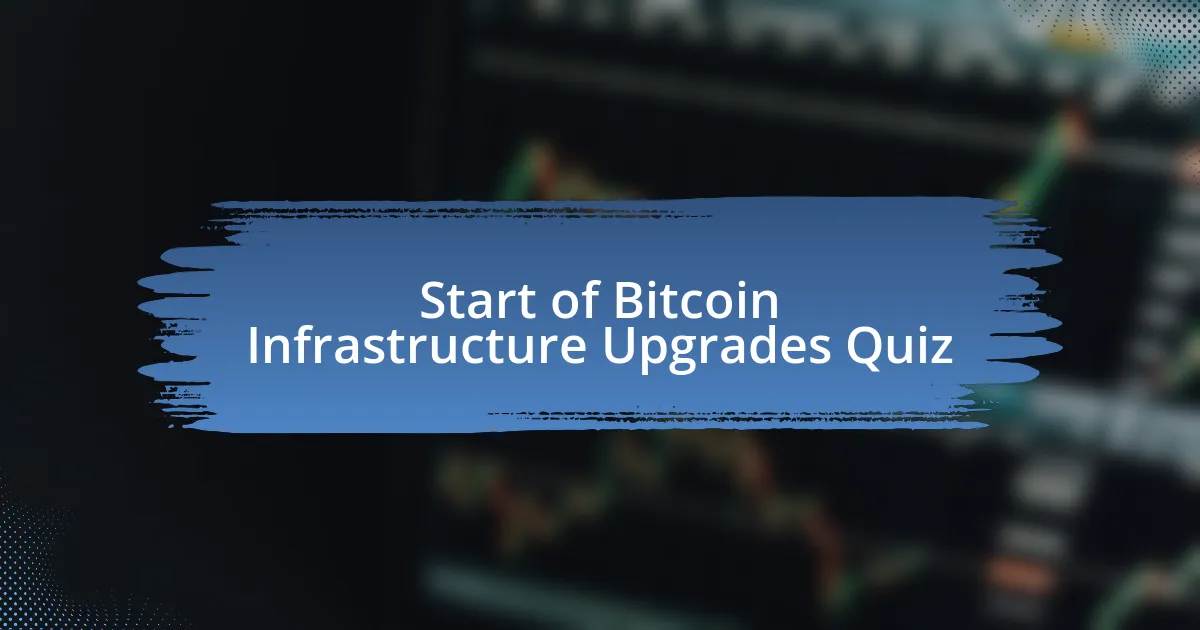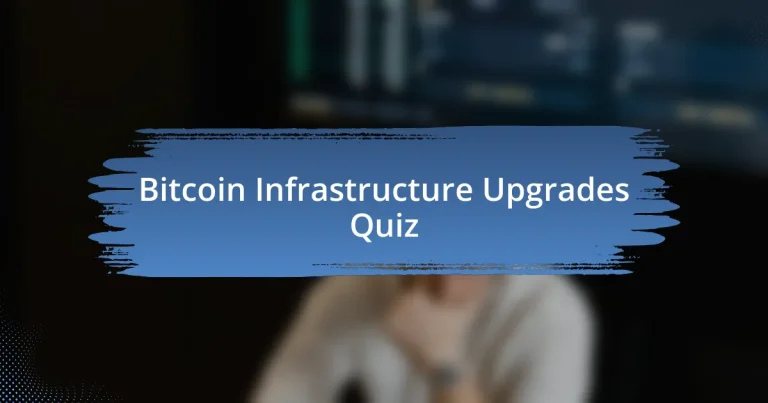
Start of Bitcoin Infrastructure Upgrades Quiz
1. What is BitcoinOS?
- BitcoinOS is a wallet application designed for storing various altcoins.
- BitcoinOS is a new cryptocurrency miner that promises faster transaction speeds.
- BitcoinOS is an operating system for Bitcoin that unlocks its infinite potential to secure the entire world`s data using zero-knowledge proofs (ZKPs) and rollups.
- BitcoinOS is an educational platform for learning about blockchain technologies.
2. What is a rollup in Bitcoin?
- A rollup is a system that creates new Bitcoin mining hardware.
- A rollup is an L2 execution environment designed to be more scalable and feature-rich than its parent L1 chain.
- A rollup is a feature to allow unlimited transactions on the base layer.
- A rollup is a type of cryptocurrency wallet for secure storage.
3. What is the purpose of ZKPs in Bitcoin?
- To verify transactions without revealing details
- To increase transaction fees and costs
- To store data securely on the blockchain
- To create new Bitcoin mining algorithms
4. What is BitSNARK?
- BitSNARK is a software library for efficiently verifying zkSNARKs on Bitcoin.
- BitSNARK is a security protocol for Bitcoin wallets.
- BitSNARK is a type of Bitcoin mining algorithm.
- BitSNARK is a trading platform for Bitcoin assets.
5. What are covenants in Bitcoin?
- Covenants are mandatory fees collected for every Bitcoin transaction.
- Covenants are temporary addresses for sending Bitcoin anonymously.
- Covenants are conditional payments that require specific proof to execute.
- Covenants are unlimited transactions executed by anyone without conditions.
6. What is the Lightning Network?
- The Lightning Network is a mining protocol that increases Bitcoin’s energy efficiency.
- The Lightning Network is a decentralized exchange for trading Bitcoin assets.
- The Lightning Network is a Layer-2 network on top of the Bitcoin blockchain that enables almost instantaneous transactions by conducting them off-chain.
- The Lightning Network is a new cryptocurrency that serves as a digital wallet.
7. How does the Lightning Network work?
- The Lightning Network works by creating payment channels between two parties in a multi-signature wallet, with transactions conducted off-chain and only the initial creation and final settlement recorded on the blockchain.
- The Lightning Network allows users to swap cryptocurrencies directly on the Bitcoin blockchain with no additional layers.
- The Lightning Network functions as a centralized exchange for Bitcoin transactions, managing all trades on a single platform.
- The Lightning Network conducts all transactions directly on-chain, increasing the load on the Bitcoin network without off-chain solutions.
8. What is the significance of the Lightning Network for Bitcoin?
- The Lightning Network enables Bitcoin to be mined on mobile devices for easier accessibility.
- The Lightning Network reduces Bitcoin`s overall supply by creating more coins.
- The Lightning Network replaces Bitcoin`s proof-of-work mechanism with proof-of-stake.
- The Lightning Network significantly increases the scalability and speed of Bitcoin transactions.
9. What are the benefits of the Lightning Network?
- Reduces the need for blockchain technology.
- Only allows large transactions to be processed.
- Increased scalability, faster transaction processing, and decreased costs.
- Increases the mining power of the network.
10. What are the challenges faced by the Lightning Network?
- Costs associated with using the network
- Limited transaction speed
- Complicated user interface
- High transaction volume
11. What is the purpose of Taproot in Bitcoin?
- Taproot facilitates instant transactions by eliminating block confirmation times.
- Taproot enhances Bitcoin transactions by implementing Schnorr signatures, improving efficiency, scalability, and privacy.
- Taproot allows for unlimited Bitcoin supply, impacting inflation.
- Taproot enables Bitcoin to conduct smart contracts without any security measures.
12. What does BIP 340 achieve in Taproot?
- Reduces transaction fees
- Increases block size limits
- Implements Schnorr signatures
- Introduces smart contracts
13. What does BIP 341 achieve in Taproot?
- BIP 341 allows for unlimited transaction sizes.
- BIP 341 enhances efficiency in Bitcoin transactions.
- BIP 341 reduces the number of miners on the network.
- BIP 341 increases the fees for Bitcoin transactions.
14. What does BIP 342 achieve in Taproot?
- BIP 342 creates digital wallets for Bitcoins
- BIP 342 implements faster transaction speeds
- BIP 342 enhances privacy in transactions
- BIP 342 reduces Bitcoin`s block size
15. What impact does Taproot have on Bitcoin transactions?
- Taproot completely replaces the Bitcoin blockchain with a new system altogether.
- Taproot improves transaction efficiency, reduces fees, and enhances smart contract functionality, making Bitcoin more scalable and private.
- Taproot increases Bitcoin`s block size limit, allowing more transactions per block.
- Taproot only enhances Bitcoin`s security by making it immune to hacking.
16. What is the significance of the Lightning Network in the context of recent developments like Bitcoin ordinals and BRC-20 tokens?
- The Lightning Network primarily increases the decentralization of Bitcoin, ensuring it remains more secure against attacks.
- The Lightning Network serves to enhance the anonymity of Bitcoin transactions, protecting user identities from exposure.
- The Lightning Network is mainly focused on smart contract functionalities, allowing for advanced applications on Bitcoin.
- The Lightning Network is crucial for enabling faster and cheaper transactions, which is essential for the adoption of new features like Bitcoin ordinals and BRC-20 tokens.
17. What is the role of Sovryn in the BitcoinOS ecosystem?
- Sovryn focuses on creating stablecoins within BitcoinOS.
- Sovryn manages compliance regulations for BitcoinOS users.
- Sovryn is responsible for maintaining Bitcoin`s core transaction protocols.
- Sovryn plans to migrate its core DEX to a dedicated BitcoinOS rollup.
18. What is the roadmap for BitcoinOS?
- BitcoinOS intends to merge with all altcoins to form a single cryptocurrency.
- BitcoinOS plans to abandon all current projects for new ones unrelated to Bitcoin.
- BitcoinOS is working with leading L2 projects to launch independent rollups on the BitcoinOS superchain, with Sovryn being one of the key projects.
- BitcoinOS will only focus on developing non-decentralized finance solutions.
19. What is the concept of a `superchain` in the context of BitcoinOS?
- A superchain is a type of Bitcoin wallet.
- A superchain is a cryptocurrency exchange platform.
- A superchain is a programming language for Bitcoin.
- A superchain is a modular architecture for BitcoinOS.
20. What is the significance of the $1.1 trillion altcoin ecosystem returning to Bitcoin?
- The return indicates a shift towards centralized altcoin systems for transaction processing.
- The return symbolizes a loss of interest in Bitcoin`s core technology and its limitations.
- The return signifies a renewed focus on Bitcoin`s decentralization and infrastructure.
- The return reflects a decrease in engagement with Bitcoin`s community and user base.
21. What is the term used for a blockchain split?
- Token
- Chain
- Fork
- Node
22. What are the types of forks in blockchain technology?
- External forks, internal forks, and hybrid forks
- Block forks, chain forks, and season forks
- Digital forks, smart forks, and virtual forks
- Soft forks, hard forks, and temporary forks
23. Which technology is used in Bitcoin?
- artificial intelligence
- cloud computing
- blockchain technology
- quantum computing
24. What are the pillars of blockchain technology?
- Speed
- Decentralization
- Immutability
- Efficiency
25. What are the benefits of blockchain technology?
- Increased paper trails for record keeping
- Limited data accessibility for users
- Enhanced security and transparency in transactions
- Slower transaction processing and higher fees
26. Where do you keep your cryptocurrency?
- USB drive
- Bank account
- File folder
- Digital wallet
27. What is the purpose of the Lightning Network in Bitcoin?
- The Lightning Network acts as a decentralized exchange for trading Bitcoin and altcoins.
- The Lightning Network is designed to speed up transaction processing times and decrease the associated costs of Bitcoin`s blockchain by enabling off-chain transactions.
- The Lightning Network serves as a backup storage solution for Bitcoin wallets.
- The Lightning Network ensures total anonymity for all Bitcoin users during transactions.
28. What are the key takeaways about the Lightning Network?
- The Lightning Network increases block size and on-chain activity.
- The Lightning Network enhances scalability and transaction speed.
- The Lightning Network operates solely on the Bitcoin base layer.
- The Lightning Network adds new coins to the Bitcoin network.
29. What recent developments have improved the Lightning Network?
- Expansion of mining capabilities
- Introduction of decentralized exchanges
- Removal of channel size constraints
- Limiting payment channel fees
30. What is the significance of the integration of the Lightning Network with cryptocurrency exchanges?
- It eliminates the need for digital wallets.
- It increases the usage and utility of the Lightning Network.
- It reduces the cost of mining Bitcoin.
- It decreases the number of transactions processed daily.

Quiz Successfully Completed!
Congratulations on finishing the quiz on Bitcoin Infrastructure Upgrades! Your journey through this topic might have shed light on the critical updates and improvements that help the Bitcoin network stay resilient and efficient. Did you learn about the importance of scalability and security? Perhaps you discovered how upgrades like Segregated Witness and the Lightning Network play a vital role in optimizing Bitcoin transactions.
Engaging with this quiz not only clarified your understanding but also sparked curiosity about the ongoing evolution of Bitcoin technology. You now have a better grasp of the complexities involved in keeping the network robust. The insights you gained here can help you appreciate the nuances of Bitcoin as it continues to adapt to the growing demands of users worldwide.
Ready to deepen your knowledge? We invite you to explore the next section on this page, where you will find detailed information on Bitcoin Infrastructure Upgrades. This resource will provide further context and clarity, expanding on the concepts you’ve just encountered. Happy learning!

Bitcoin Infrastructure Upgrades
Understanding Bitcoin Infrastructure Upgrades
Bitcoin infrastructure upgrades refer to updates and enhancements made to the underlying technology and protocols of the Bitcoin network. These upgrades aim to improve scalability, security, and usability. They play a crucial role in addressing challenges such as transaction speed, costs, and network congestion. Upgrades often involve soft forks or hard forks, where soft forks maintain backward compatibility while hard forks create a new version of the blockchain. Recent examples include Segregated Witness (SegWit) and the Taproot upgrade, which enhance transaction efficiency and privacy.
The Importance of Scalability in Bitcoin
Scalability is vital for the Bitcoin network to handle an increasing number of transactions efficiently. Infrastructure upgrades often focus on improving scalability to ensure the network can support growth without sacrificing speed or increasing fees. Techniques such as the Lightning Network facilitate off-chain transactions, thereby reducing on-chain congestion. These innovations aim to allow Bitcoin to function as a viable daily transaction currency.
Key Infrastructure Upgrades: Segregated Witness (SegWit)
Segregated Witness (SegWit) is a significant upgrade implemented in 2017. It separated transaction signatures from the transaction data, effectively increasing the block size limit. This separation allowed more transactions to be included in each block, improving transaction throughput and reducing fees. By modifying how data is stored, SegWit also laid the groundwork for further innovations like the Lightning Network, enhancing overall network efficiency.
Taproot Upgrade Explained
Taproot, activated in November 2021, is a major upgrade that enhances Bitcoin’s scripting capabilities. It allows for more complex transactions while maintaining privacy. By enabling users to hide transaction types and conditions, Taproot improves fungibility and obscures details that can be revealing. This upgrade makes multi-signature transactions indistinguishable from standard transactions, ensuring better privacy for users.
Future Directions of Bitcoin Infrastructure Upgrades
The future of Bitcoin infrastructure upgrades will likely focus on further enhancing scalability and privacy. Upcoming proposals aim to optimize the integration of layer two solutions, like the Lightning Network, to facilitate faster and cheaper transactions. Additionally, developments in privacy technologies may emerge, addressing concerns about user anonymity. Continuous community engagement will be crucial for the evolution of the Bitcoin protocol and its infrastructure.
What are Bitcoin infrastructure upgrades?
Bitcoin infrastructure upgrades are enhancements or changes made to the Bitcoin network and its associated systems to improve performance, security, and user experience. These upgrades can include updates to the core Bitcoin software, changes in transaction protocols, and adjustments in mechanisms for scalability and privacy. For instance, the implementation of Segregated Witness (SegWit) in 2017 improved transaction capacity and paved the way for second-layer solutions like the Lightning Network, which further enhances Bitcoin’s usability and efficiency.
How are Bitcoin infrastructure upgrades implemented?
Bitcoin infrastructure upgrades are implemented through a process known as a Bitcoin Improvement Proposal (BIP). Developers propose improvements, which are discussed and refined by the community. After consensus is reached, the new code is integrated into the Bitcoin Core software. Miners and nodes must update their software to activate these upgrades. A concrete example is the Taproot upgrade, which was activated in November 2021. It introduced more advanced scripting capabilities and better privacy for transactions.
Where can one find information about upcoming Bitcoin infrastructure upgrades?
Information about upcoming Bitcoin infrastructure upgrades can be found on various platforms, including the official Bitcoin Developer Documentation, Bitcoin-related forums such as Bitcoin Talk, and GitHub repositories for Bitcoin Core. Additionally, social media platforms, newsletters, and podcasts dedicated to Bitcoin often provide updates and discussions about proposed upgrades. For instance, Bitcoin’s GitHub page lists all current and proposed BIPs, providing detailed descriptions and discussions of each upgrade.
When do Bitcoin infrastructure upgrades occur?
Bitcoin infrastructure upgrades occur as needed, typically in response to technological advancements, security needs, or community proposals. The timeline for these upgrades can vary significantly. For example, the SegWit upgrade was proposed in 2015 and activated in August 2017, while the Taproot upgrade took approximately three years from proposal to activation in November 2021. Each upgrade’s timing depends on consensus within the community and the complexity of the changes.
Who is responsible for Bitcoin infrastructure upgrades?
Responsibility for Bitcoin infrastructure upgrades lies primarily with the Bitcoin Core development team, which consists of volunteer developers from around the world. These developers maintain the Bitcoin protocol and propose improvements based on community feedback and technological developments. Significant proposals are often scrutinized through discussion within the broader Bitcoin community, including miners, node operators, and users, ensuring a decentralized decision-making process. A notable figure in this process is Pieter Wuille, a prominent developer who has contributed significantly to major upgrades like SegWit and Taproot.


